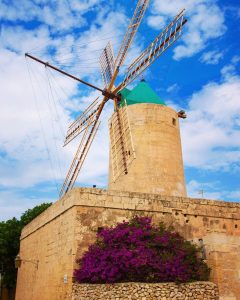1. Ġgantija Temples, Xagħra

Ġgantija Temples, Xagħra – Instagram @juliasomething
This ancient site in Xaghra, consists of two temples dates back to 3600BC till 3200BC and is included in the UNESCO World Heritage lists. This site is considered as one of the oldest free standing monuments in the world preceding popular place such as Stonehenge and the Egyptian Pyramids.
The temples derive the name from a popular local myth. Gozitans believed the temples were constructed by a gigantic race of people–Ġgantija means ‘Place of Giants’ in Maltese.
Remains of animal bone discovered in this site suggest some sort of ritual involving animal sacrifice. The use of fire is shown by the presence of stone hearths. A number of libation holes in the floor may have been used for the pouring of liquid offerings.
Opening hours: Thursdays to Sundays between 10:00hrs and 16:30hrs.
2. Cittadella, Victoria
The Cittadella is in the centre of Gozo, Malta’s sister island. The small fortified town is situated on a promontory site over Victoria. This vantage point was obviously chosen because it was a naturally fortified hill which dominated the surrounding countryside and provided visual control of the coastal areas.
Most of what can be seen today of the Cittadella originates from medieval times when the city was transformed into a castle. By this time over a third of the people of Gozo lived around the Cittadella. For safety reasons they were required to spend the night within its walls. The Order of St. John used the fortress as a form of defense against Ottoman attacks on Gozo, of which there were quite a few. Over the years the Knights rebuilt and strengthened the walls of the Cittadella to turn it into the imposing structure we see today.
Upon entering the walls of Cittadella one can find an abundance of sites to visit such as the Cathedral church, such as the Museum of Archaeology, the Cathedral Museum, the Folklore Museum and the Nature Museum, and the old prison.
An extensive 5 year restoration project of the site was completed recently leaving the Cittadella looking absolutely amazing. This massive project was undertaken to clean up the ruins and restore many of the buildings to their former glory. Interestingly, the excavation works unearthed many previously unseen parts of the Cittadella such as the original entrance and many underground tunnels. The Cittadella, in its renovated state, now stands proudly in silent watch over Victoria.
Opening hours: Cittaddella is open all day long. Check Heritage Malta website regarding museums opening hours.
3. Ta’ Kola Windmill, Xagħra

Ta’ Kola Windmill Photo: Instagram @awstruckwander
Ta’ Kola Windmill is situated in the heart of the village of Xaghra, a few metres away from Ġgantija Temples. It is one of the few surviving windmills on the Maltese Islands dating back to the Knights’ Period and a fine example of the rural economy and domestic life of Gozo in past centuries.
The origins of this windmill go back to 1725, during the magistracy of Grand Master Manoel de Vilhena. Apparently, the use of bad quality stones and mortar, led to its dismantling and reconstruction in the 1780s.
Its construction follows a plan which is echoed in most Maltese windmills of the period, consisting of a number of rooms on two floors surrounding the centrally-placed cylindrical stone tower. The latter houses the wooden milling mechanism that still incorporates the original circular grinding stones between which grain is crushed into flour.
Ġużeppi Grech was the last miller responsible for operating and maintaining the structure, and resided in this windmill until his death in 1987. He was an ingenious craftsman and many of the tools on display were created by him. The windmills name Ta’ Kola is (son of Nikolas) is how Guzeppi was affectionately known by locals.
Opening hours: Thursdays to Sundays between 10:00hrs and 16:30hrs.
4. Xwejni Salt Pans, Żebbug

Xwejni Salt Pans, Zebbug
Photo: Instagram @avychev17
On the northern coast of the Maltese island of Gozo, mounds of snow-white salt sparkle under the summer sun in
salt evaporation pans. About 300 of these pans cover a section of Gozo’s northern coast, called the Xwejni Salt Pans.
The formation process of the salt begins when sea water starts to fill crevices in the coastline. This sea water is left to settle for eight days before it is moved to smaller salt pans that are warmer in temperature and further away from the sea. At the beginning of the drying process the water takes on a reddish hue and salt crystals begin to form.
The salt pans are ingrained in the Gozitan tradition of sea salt production, a custom that has been passed down within local families for generations. During the summer months, locals can be seen scraping off salt crystals from the rock face, all collected, processed and packaged by hand.
Opening hours: Open all day but Salt collection can be seen in the summer months.
 It-Tokk, Independence Square, Victoria, Gozo | Ta’ Dbiegi Crafts Village, Gharb, Gozo
It-Tokk, Independence Square, Victoria, Gozo | Ta’ Dbiegi Crafts Village, Gharb, Gozo



0 comments
Write a comment